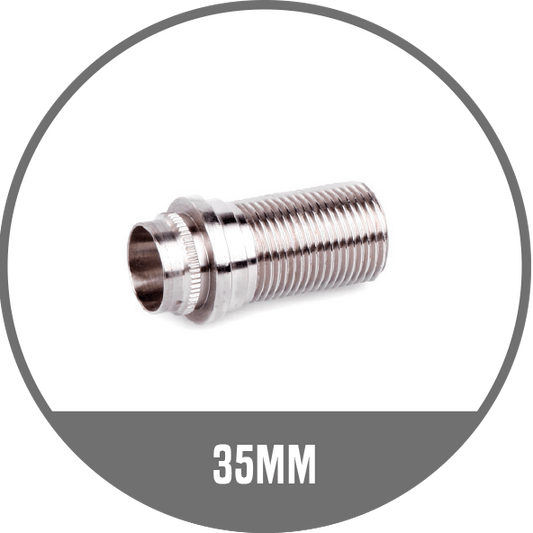Collection: Stout / Nitro Coffee taps
The Cream or Creaming Plate is a fascinating innovation in the field of beer tapping. This special plate is placed under or in the tap and has an important task: it ensures that the beer is tapped with a mixture of nitrogen and carbon dioxide. The result? The famous creamy head that makes Guinness beers so distinctive.
The creamy foam head is not only a visual highlight, but also influences the taste. It gives the beer a velvety texture and a pleasant mouthfeel. No wonder Guinness fans all over the world love this foamy head!
So next time you enjoy a Guinness, think about the small cream plate - it's the secret star that makes the perfect beer experience possible.
-
Stout tap with compensator
Regular price €89,99 EURRegular priceUnit price / per -
Stout/Guinness tap
Regular price €135,00 EURRegular priceUnit price / per -
Stout tap with creaming plate
Regular price €173,00 EURRegular priceUnit price / per -
“EUROSTAR JUNIOR” tap, matt
Regular price From €116,00 EURRegular priceUnit price / per -
Refined tap JUNIOR Stout / Nitro Coffee, polished
Regular price From €125,00 EURRegular priceUnit price / per -
Raffeiner JUNIOR tap Stout / Nitro Coffee, matt gold
Regular price From €125,00 EURRegular priceUnit price / per -
Tap, compensator tap, beer tap, dispensing tap - Raffeiner JUNIOR Stout/Nitro Coffee, polished gold
Regular price From €135,00 EURRegular priceUnit price / per -
Refined tap JUNIOR Stout/Nitro Coffee, matt copper
Regular price From €135,50 EURRegular priceUnit price / per -
Refined Eurostar tap Stout / Nitro Coffee
Regular price From €148,00 EURRegular priceUnit price / per -
Refined Eurostar tap Stout / Nitro Coffee, Inox Gold
Regular price From €158,00 EURRegular priceUnit price / per -
Refined Eurostar tap Stout / Nitro Coffee, dark copper
Regular price €170,00 EURRegular priceUnit price / per -
Refined Eurostar tap Stout / Nitro Coffee, Dark Inox
Regular price €165,00 EURRegular priceUnit price / per -
Refined Eurostar tap Stout / Nitro Coffee, Dark
Regular price €170,00 EURRegular priceUnit price / per
Buy a Guinness tap: How to bring the pub feeling home
A freshly tapped Guinness is more than just a beer – it's an experience. With your own Guinness tap, you can bring that feeling right into your kitchen, party room, or home bar. It's not just about the taste, but also the unique look of the creamy foam created by nitrogen.
The signature tapping process is part of the fascination and makes tapping Guinness a true highlight for beer lovers. When you buy a Guinness tap, you're investing in quality and authenticity. The matching Guinness tap system enables controlled dispensing and ensures the famous two-step tapping – just like in a pub. It's important that you choose a model that's compatible with Guinness nitrogen cartridges or a corresponding tap system.
This way you can enjoy the unmistakable Guinness experience in style at home – whether it’s during a cozy evening or at the next football game with friends.
How does a Guinness nitrogen tap work?
A classic Guinness tap works differently than conventional beer dispensing systems. While regular taps usually use CO₂, Guinness requires a special mixture of nitrogen and carbon dioxide – usually with a high nitrogen content. This gas mixture is pumped into the keg through the Guinness tap and creates the characteristic thick, creamy head that makes Guinness so unmistakable. The nitrogen ensures that the beer flows into the glass with a velvety texture, creating the signature look of the slowly rising head.
When tapping with a Guinness tap, the beer is poured into the glass in two stages: first, about three-quarters full, followed by a short wait, and finally, the final refill until the perfect pint is reached. This exact process is only possible with a special Guinness tap, as conventional taps cannot achieve the fine nitrogen distribution. It is important that the entire Guinness dispensing system—from the keg to the pipe to the tap—is tuned to the special gas mixture. This is the only way to develop the full flavor combined with the typical foam.
Difference between Guinness taps and conventional beer taps
The differences between a Guinness beer tap and conventional beer dispensing systems are clear and have a significant impact on the taste and presentation. A standard tap operates with CO₂ and is designed for classic, coarse-pored beer foam. The Guinness tap, on the other hand, was specifically developed for beers dispensed with nitrogen—especially Guinness itself. The result: a particularly soft, dense foam with a silky texture.
The interior of the tap is also specially designed. The Guinness tap has a restrictor plate that forces the beer through tiny openings when tapping. This creates the distinctive foam that is so important when tapping Guinness at home. The tapping speed and the pressure with which the beer comes out of the keg also vary. With a Guinness tap system, everything is precisely coordinated: from the nitrogen mixture to the temperature and the tapping angle. Anyone who tries to pour Guinness from a regular tap will quickly notice that both the consistency and the appearance of the beer are different from the original. For an authentic experience, there is no way around a suitable Guinness tap.
Connecting a Guinness tap: A guide for beginners
Connecting a Guinness tap is straightforward – provided you have the right accessories. To dispense Guinness at home, you'll need a suitable Guinness tap system, a suitable keg connector, ideally nitrogen or a pre-filled gas cartridge, and, of course, the specially designed Guinness tap. Important: The tap must be designed for use with nitrogen, as this is the only way to produce the signature foam.
First, connect the keg to your Guinness dispensing system. Ensure that all lines are hygienically clean and tightly connected. Next, connect the gas source. With systems like the Guinness Micro Draught, this step is unnecessary, as it uses an integrated gas cartridge system. As soon as the line is pressurized, you can operate the tap. It's recommended that you hold the glass at an angle and only fill it about three-quarters full. After a short wait, the second dispensing process follows. This way, you can enjoy the typical Guinness pint with the perfect head—even in your own home.
Cleaning and maintaining a Guinness dispensing system – this is how it’s done correctly
Regular cleaning of your Guinness dispensing system is essential to ensure the long-term quality of the beer. Residues in the hoses or the Guinness tap can not only negatively affect the taste but also cause hygiene problems. At least once a week, all components—from the line to the tap—should be thoroughly cleaned. Use special cleaning agents suitable for beer lines and rinse thoroughly with water afterward.
The Guinness tap should also be disassembled and cleaned regularly, especially the fine openings in the restrictor plate. The nitrogen system—whether cartridge or gas cylinder—should also be checked regularly and replaced if necessary. This is the only way to ensure consistently high quality Guinness dispensing at home and simultaneously extend the lifespan of your entire Guinness dispensing system.














